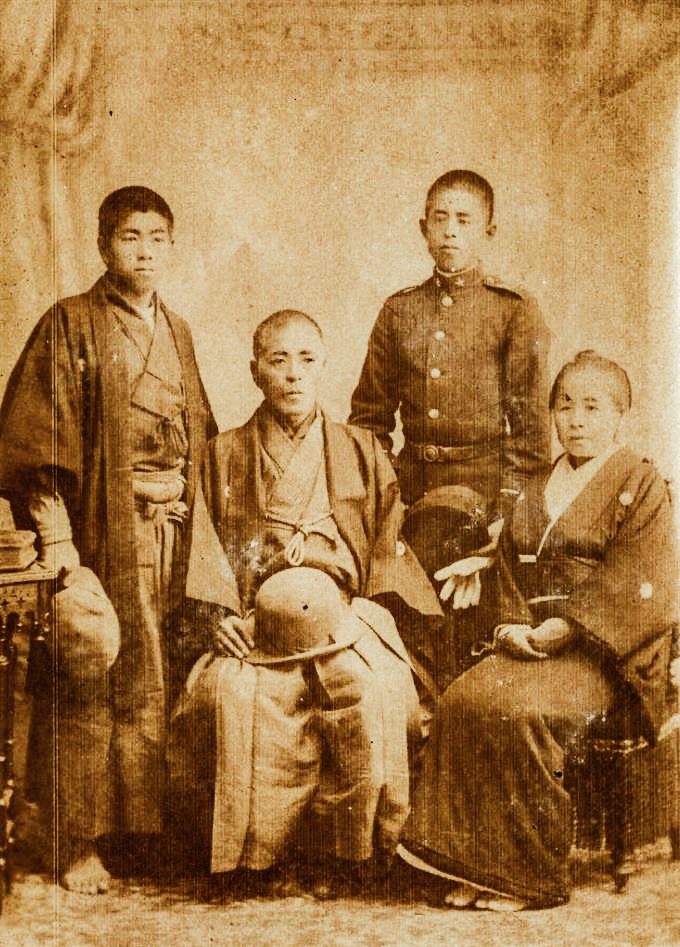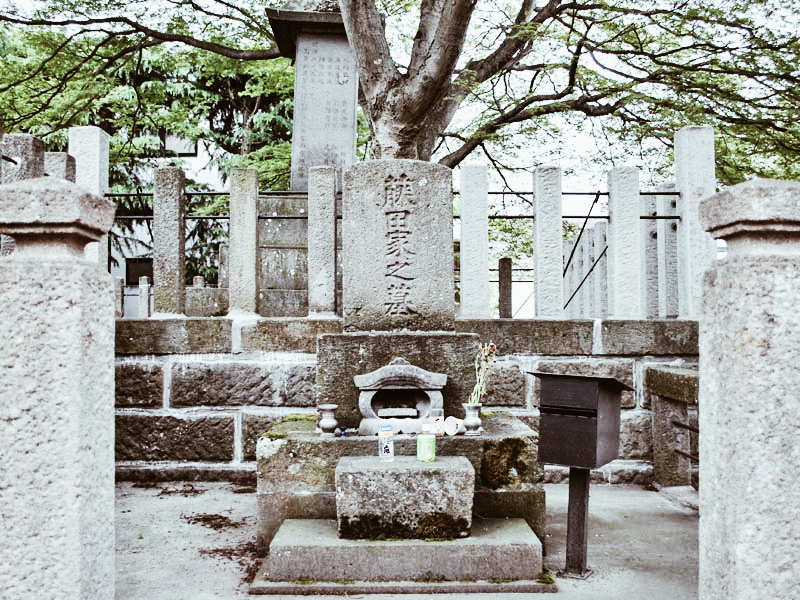Saitō Hajime (Yamaguchi Hajime, February 18, 1844 – September 28, 1915) was a Japanese samurai of the late Edo period, who served as the captain of the third unit of the Shinsengumi. He was one of the few core members who survived the numerous wars of the Bakumatsu period. He was later known as Fujita Gorō and worked as a police officer in Tokyo during the Meiji Restoration.
Saitō Hajime of the third unit of the Shinsengumi
Author: SaiKaiAngel

photo credits: wikipedia.org
He was born in Edo, Musashi Province (now Tokyo) as Yamaguchi Hajime and he had an older brother named Hiroaki and an older sister named Katsu. According to the published records of his family, Saitō left Edo in 1862, after accidentally killing a hatamoto (a samurai in the direct service of the Tokugawa shogunate of feudal Japan).
He went to Kyoto and taught in the dōjō of a man named Yoshida who had relied on Saitō’s father Yūsuke in the past. His style of swordsmanship is not clear. According to a tradition of his descendants, his style comes from Ittō-ryū and to be a Mugai Ryū that originates from Yamaguchi Ittō-ryū. He is also considered to have learned Tsuda Ichi-den-ryū and Sekiguchi-ryū.
He adherently lived by the Shinsengumi code “Aku Soku Zan” ( literally: “Slay Evil Immediately”, but more poetically rendered as “Swift Death to Evil”), though he never has shown much regard for human life, at some points even letting on that he likes to kill. He was rather arrogant, but none of these flaws prevent him from being a superb investigator and fighter. He expected those involved in the military, whether Shinsengumi swordsmen or Meiji era policemen, to carry out their duties without letting their personal feelings interfere.
He believed in peace and order, even in the society created by his former enemies. Throughout the series, to uphold this new peace, Saitō has often been shown as the foil of Himura Kenshin who walks and carries out his duties in the shadows of society in his own way; following his lifelong code of purpose with devotion, Saitō was the man who did the dirty work, killing off the bad persons. Anyone he considered to be corrupt or despotic was a target for elimination, in the honor of his country and his fallen men.
Even if he was normally serious, Saitō had a slight sense of humor that is also a lot sadistic, shown as he used his sword to casually attempt to stab Sanosuke Sagara in the butt through the roof of the horse carriage they were riding with Himura Kenshin.
During the Kyoto Arc, Saitō joined forces with Himura Kenshin to fight against Shishio Makoto. However, he considered Kenshin to be more of an adversary rather than an ally. Later, after acknowledging Himura Kenshin’s vow to never kill again, Saitō decided to put an end to their rivalry.
Saitō was an able observer and a quick analyst (working as a spy for the Meiji government). In addition to being a skilled swordsman, he is revealed to possess immense physical strength when he punched the herculean Sagara Sanosuke in a hand-to-hand fistfight. He considered Sanosuke to be a dimwitted amateur with mild potential, due mostly to Sano’s lack of insight.
Saitō was highly recognizable by his narrow eyes, “spider-like” strands of hair in front of his forehead (he was also said to resemble a wolf), his propensity for smoking and the katana on his left side.
Shinsengumi Period
As a member of the Shinsengumi, Saitō was said to be an introvert and a mysterious person; a common description of his personality says he ” he was not a man predisposed to small talk” but unusually tall 180 cm. He was also noted to be very dignified, especially in his later years, he always made sure that his obi was tied properly and when he walked he was careful not to drag his feet and he always sat in the formal position, called seiza. He also was very alert so that he could react instantly to any situations that might occur.
He was known to be very intimidating when he wanted to be. Along with his duties as Captain of the Third Squad in the Shinsengumi, he was also responsible for weeding out any potential spies within the Shinsengumi ranks.
His original position within the Shinsengumi was assistant vice commander. During the Ikedaya incident on July 8, 1864, Saitō was with Hijikata Toshizō’s group that arrived later at the Ikedaya Inn.
In August 20, 1864, Saitō and the rest of the Shinsengumi took part in the Kinmon incident against the Chōshū rebels. In the reorganization of the ranks in November 1864, he was first assigned as the fourth unit’s captain and would later receive an award from the shogunate for his part in the Kinmon incident.
At the Shinsengumi new headquarters at Nishi Hongan-ji in April 1865, he was assigned as the third unit’s captain. Saitō was considered to be on the same level of swordsmanship as the first troop captain Okita Sōji and the second troop captain Nagakura Shinpachi. In fact, it seems that Okita feared his sword skill.
Despite prior connections to Aizu, his descendants dispute that he served as a spy. His controversial reputation comes from accounts that he executed several corrupt members of the Shinsengumi; however, rumors vary as to his role in the deaths of Tani Sanjūrō in 1866 and Takeda Kanryūsai in 1867. His role as an internal spy for the Shinsengumi is also questionable; he is said to have been instructed to join Itō Kashitarō’s splinter group Goryō Eji Kōdai-ji faction, to spy on them, which eventually led to the Aburanokōji incident in December 13, 1867.
Together with the rest of the Shinsengumi, he became a hatamoto in 1867. In late December 1867, Saitō and a group of six members of the Shinsengumi were charged with protecting Miura Kyūtarō, who was one of the main suspects in the murder of Sakamoto Ryōma. On January 1, 1868, they fought against sixteen assassins who tried to kill Miura in revenge at the Tenmaya Inn for what was known as the Tenmaya incident.
After the outbreak of the Boshin war from January 27, 1868 onwards, Saitō, under the name of Yamaguchi Jirō, participated in the Shinsengumi’s fight during the battle of Toba-Fushimi and the battle of Kōshū-Katsunuma, before retiring with the surviving members in Edo and later in the domain of Aizu.
Saitō became commander of the Aizu Shinsengumi around May 26, 1868 and continued in the battle of Shirakawa. After the battle of Bonari Pass, when Hijikata decided to withdraw from Aizu, Saitō and a small group of 20 members separated from Hijikata and the rest of the surviving Shinsengumi, continued to fight alongside the Aizu army against the imperial army until the end of the battle of Aizu. This separation was recorded in the diary of the conservative Kuwana Taniguchi Shirōbei, where it was recorded as an event that also involved Ōtori Keisuke, who Hijikata asked to take command of the Shinsengumi; therefore the aforementioned clash was not with Hijikata.
Saitō, together with the few remaining men of the Shinsengumi who went with him, fought against the imperial army at Nyorai-dō), where they were severely outnumbered. It was during the battle of Nyorai-dō that Saitō was thought to have been killed in action; however, he managed to return to the lines of Aizu and joined the army of Aizu’s domain as a member of the Suzakutai. After the fall of the Aizuwakamatsu castle, Saitō and the five surviving members joined a group of former Aizu services who traveled southwest to the Takada domain in Echigo province, where they were held as prisoners of war. In the registers listing the Aizu men detained in Takada, Saitō is registered as Ichinose Denpachi.
Meiji Restoration
Saitō, under the new name of Fujita Gorō, went to Tonami, the new domain of the Matsudaira clan of Aizu. He settled with Kurasawa Heijiemon, the karō of Aizu who was an old friend of his from Kyoto. Kurasawa was involved in the migration of Aizu samurai to Tonami and the construction of settlements in Tonami, particularly in the village of Gonohe. In Tonami, Fujita met Shinoda Yaso, daughter of an Aizu believer. The two met through Kurasawa, who then lived with Ueda Shichirō. Kurasawa sponsored the marriage of Fujita and Yaso on August 25, 1871. It was also during this period that Fujita may have been associated with the Police Office. Fujita and Yaso moved out of the Kurasawa house on February 10. When he left Tonami for Tokyo on June 10, 1874, Yaso moved to Tokyo with Kurasawa and the last registration of the Kurasawa family dates back to 1876. It is not known what happened after that. It was during this period that Fujita Gorō started working as a police officer in the Tokyo Metropolitan Police Department.
In 1874 Fujita married Takagi Tokio, the daughter of Takagi Kojūrō, a servant of the Aizu domain. Her original name was Sada; she served for a time as a companion of Matsudaira Teru. Fujita and Tokio had three children: Tsutomu (1876-1956); Tsuyoshi (1879-1946); and Tatsuo (1886-1945). Tsutomu and his wife Nishino Midori had seven children; the Fujita family continues to this day through Tarō and Naoko Fujita, the children of Tsutomu’s second son, Makoto. Fujita’s third son, Tatsuo, was adopted by the Numazawa family, maternal relatives of Tokyo whose family had been almost annihilated during the Boshin war.

photo credits: wikipedia.org
Fujita fought on the Meiji government’s side during Saigō Takamori’s Satsuma rebellion, as a member of the police forces sent to support the Imperial Japanese Army.
During his lifetime, Fujita Gorō shared some of his Shinsengumi experiences with a select few, but he didn’t write anything about his activity in the Shinsengumi as Nagakura Shinpachi did. During his life in the Meiji period, Fujita was the only one who was authorized by the government to carry a katana despite the collapse of the Tokugawa rule. In 1875, Fujita assisted Nagakura Shinpachi (as Sugimura Yoshie) and Matsumoto Ryōjun in setting up a memorial monument known as Grave of Shinsengumi in honor of Kondō Isami, Hijikata Toshizō, and other deceased Shinsengumi members at Itabashi, Tokyo.
Following his retirement from Tokyo Metropolitan Police Department in 1890, Fujita worked as a guard for Tokyo National Museum, and later as a clerk and accountant for Tokyo Women’s Normal School from 1899.

photo credits: wikipedia.org
Fujita’s heavy drinking was believed to have contributed to his death from a stomach ulcer. He died in 1915 at age 72, sitting in seiza in his living room. Upon his will, he was buried at Amidaji, Aizuwakamatsu, Fukushima, Japan.
Share this:
- Click to share on Facebook (Opens in new window)
- Click to share on Twitter (Opens in new window)
- Click to share on Tumblr (Opens in new window)
- Click to share on Pinterest (Opens in new window)
- Click to share on Telegram (Opens in new window)
- Click to share on WhatsApp (Opens in new window)
- Click to share on Reddit (Opens in new window)
- Click to print (Opens in new window)






